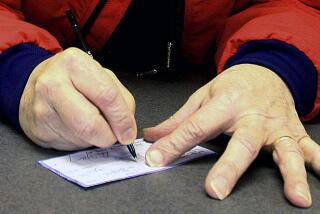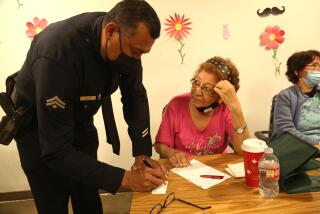Savings Bond Error Ends Up Wasting a Lot of His Energy
- Share via
It was just a small banking problem, really. Something that a guy writing about banks and savings and loans for a few years ought to be able to fix.
But the bureaucracy gets us all, and as I tried to correct the problem, I caught myself ready to laugh and scream at the same time.
One of my friends had given my infant son a U.S. savings bond for Christmas. Giving a bond as a gift, especially to newborns, is an old and noble tradition among many Americans. As long as we have such a huge national deficit, I figure, some of it should be owed to my family.
The trouble with this bond, though, was that the last name was spelled wrong. Now banks probably would cash a bond if the name is only slightly misspelled or if the customer is well known to the bank.
But I didn’t want to chance it, especially since several letters were transposed. Besides, I thought, it should be easy to fix the misspelling. I’m now quite certain that it must be easier to break into an armored Brinks truck than it is to correct a misspelled name on a U.S. savings bond.
I could have mailed the bond back to my friend and asked him go to the Palm Springs bank that issued the bond to fix it. But that’s sort of like returning a shirt and asking the gift-giver to go to the store to get a different color. Besides, my friend made the mistake to begin with, and I didn’t want to chance a second attempt.
So off I traipsed to my bank, which is really a savings and loan, and learned Lesson No. 1: S&Ls; don’t do savings bonds. You have to go to a bank, and many banks don’t like dealing with people who aren’t their customers.
Oh.
Well, Security Pacific National Bank has a branch near my office, so I decided to go there. I explained the situation to a teller. She had no idea what to do and, after consulting with a higher-up, gave me a toll-free number to the bank’s customer service department.
Back at my office, I called the number and an agent said the branches are supposed to handle that. So back to the branch I went.
There, a different teller explained Lesson No. 2: Most banks in the West don’t even issue bonds anymore. They collect the money and send it to the Federal Reserve Bank in Kansas City, which mails the bond out. So they can’t correct a misspelling unless they issued the bonds, and even then, I had to get a form from the Federal Reserve, fill it out and send it back with the bond.
Oh.
The teller gave me a toll-free number to the Federal Reserve--(800) 333-1010. I called for a form and it was sent out. Usually, government forms are harder to understand than Egyptian hieroglyphics, but this one wasn’t too bad. At least the woman at the Federal Reserve had told me what to write on Line 6.
Again, I went to the Security Pacific branch to have someone there certify my signature and implant the bank’s “Official Stamp or Seal,” as the instructions on the form required.
Again I got a new teller and had to tell her the whole story again. After consulting with co-workers, she said the bank didn’t have to sign it. The Federal Reserve would accept it with just my signature.
But the federal agency wouldn’t. It kept the bond but sent the form back so a bank could certify my signature. I went back to the local bank, and this time went to the branch manager. The lessons became more predictable.
Lesson No. 3: Banks don’t certify anything.
Lesson No. 4: Banks don’t have stamps or seals.
Lesson No. 5: Banks don’t verify signatures of people they don’t know.
Oh.
That last lesson really got to me. I wanted to ask the manager how many customers she really knew. But, to her credit, she finally agreed to call the Federal Reserve herself to find out what to do. She explained to the Federal Reserve that because I wasn’t a customer, she could only guarantee my signature based on my driver’s license, not on a bank signature card.
The woman on the line from Kansas City assured her that a driver’s license was OK. So was an ink impression from an ordinary rubber stamp with the bank’s name on it.
Now, I’m waiting for the Federal Reserve to send out a new bond with the last name spelled correctly. I hope to get it resolved by the time my son reaches 7, which is when the bond matures.
For his first birthday a few weeks ago, he received a savings bond from my mother. The middle initial was wrong. This one I’m sending back to her.
More to Read
Inside the business of entertainment
The Wide Shot brings you news, analysis and insights on everything from streaming wars to production — and what it all means for the future.
You may occasionally receive promotional content from the Los Angeles Times.










